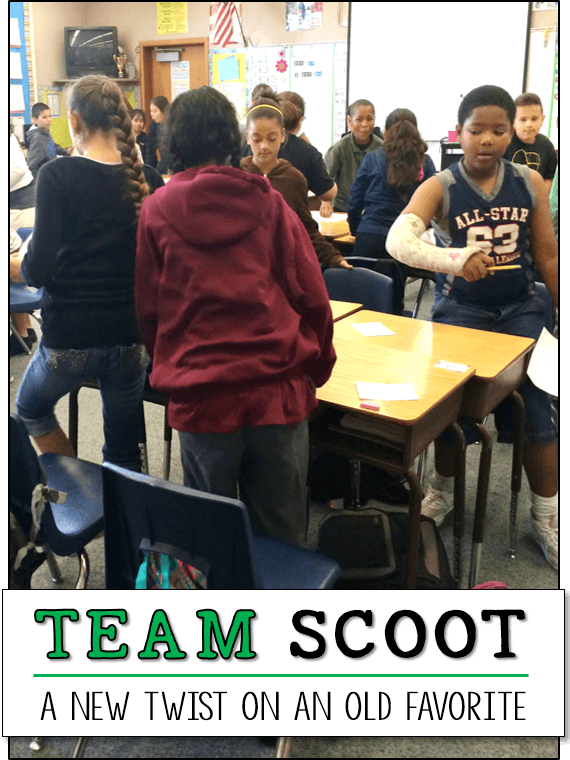Have you heard of the popular class review game called Scoot? It’s a whole class activity that gets kids up and moving from one seat to another as they solve problems. Before the game, place a different task card on each student’s desk, and give each student a blank numbered worksheet. To start the game, ask everyone to solve the problem on their task card and record the answer in the appropriate numbered spot on the worksheet. When everyone has finished, say, “Scoot!” and everyone stands up and moves to the next desk. Students leave their task cards in place and take their recording pages with them. The activity is repeated until every student has finished all the task cards.
How Effective is Whole Class Scoot?
Scoot sounds fun and educational because kids are up and moving while they learn. But when you begin to analyze the whole class version of the game, it’s clear that it’s not the best choice as a learning and review game. Kids are moving and answering questions, but they aren’t interacting with each other which is necessary for higher level thinking. Consider these questions and you’ll see what I mean…
- What if a student has no idea how to solve the problems?
- Where’s the discussion and interaction that leads to higher level thinking and processing?
- When do the answers get checked?
- Does the teacher take the student papers home to check?
- If so, when do students who had trouble with the concept actually get help with it?
- If not and students are checking their own answers after each task card, when do they get to ask for help if they miss a problem?
Have you had any of these concerns? I love the basic concept, but this version of the game leaves a lot to be desired in terms of Scoot being an effective learning activity.

Team Scoot Cooperative Learning Game
I decided to modify the basic Scoot directions to create a cooperative learning version called Team Scoot. In this version, the kids “scoot” around their teams rather than the whole class and only solve four problems at a time. Then they stop to check and discuss their answers as a team before completing four more task cards. Adding time to check and discuss answers allows students to experience those “ah ha” moments of understanding that happen when you learn from a mistake. Students can see how others solve the same problem, and they experience the feeling of being an “expert” when they can help a classmate. Another benefit is that the teacher doesn’t have any papers to grade at the end of the activity because the students check them after every four task cards. No papers to grade and kids are learning? What more could you ask?!
To make the activity easy to implement, I typed the directions for Team Scoot and added a variety of recording pages for different types of problems. If you’d like to try this cooperative learning game with your students, you can download my Team Scoot freebie from TpT.
Kid Tested and Approved!
As confident as I felt about my cooperative learning version of the activity, I didn’t want to share it on my blog until it had been tested with kids. So I asked a few teachers to test Team Scoot with their students. Fifth grade teacher Lori Tanner tried it with her class, and they loved it! They are shown in the image at the top of the post and in the two below.

Lori explained, “I tried out your Team Scoot activity with my fifth graders using some math task cards that I already had on hand. The directions were clear and my students seemed to understand them without much issue. I loved the level of engagement. Something as simple as being able to ‘scoot’ within the group kept kids engaged as they were anxious to make their way around their table group. My students enjoyed having the opportunity to discuss/defend their answers. I can see using this across content areas with short answer response questions as well.”
Why Students Love Team Scoot
Lori asked her students what they liked about Team Scoot, and here are a few of the responses:
- Annika: I loved the way we got to talk together as a team at the end. I think it was a great way to check our answers after we finished our four problems.
- Jesse: I liked that we were able to talk about how we got our answers with each other. Even though we had the same answers, we didn’t always do the problems in the same way.
- Heaven: This is faster and much more fun than doing review from our book. I like it because it challenged me mentally and got me moving too.
- Nailea: I like that you get to move around. That made doing the work more fun than doing an independent worksheet. I also like how you get to help other students who need help and you can get help from others if you need it.
- Lisved: I liked it at the end when we got to discuss our answers and check what was wrong and what was right. I also liked the part when we had to rotate and move. In fact, I liked everything about this activity and I had a lot of fun the whole entire time.
Where to Find Task Cards for Team Scoot
If you need task cards for this activity, click over to the Task Cards category in my TpT store. You’ll find sets of task cards in many subject areas as well as games that include task cards you can use with Team Scoot. If you try Team Scoot, please review the Team Scoot freebie on TpT and let me know how it goes! Thanks to Lori Tanner’s class for testing out Scoot and giving it a big thumbs up!










